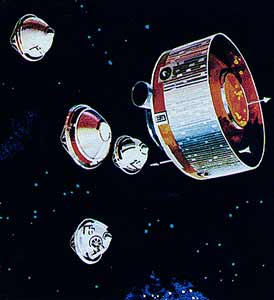Thank you very much for visiting Gunter's Space Page. I hope that this site is useful and informative for you.
If you appreciate the information provided on this site, please consider supporting my work by making a simple and secure donation via PayPal. Please help to run the website and keep everything free of charge. Thank you very much.
Pioneer 13 (Pioneer Venus Multiprobe, PVM)

Pioneer 13 with 4 landers [NASA]
The Pioneer Venus Multiprobe (PVM, Pioneer 13) consisted of a bus which carried one large and three small atmospheric probes. The large probe was released on 16 November 1978 and the three small probes on November 20. All four probes entered the Venus atmosphere on December 9, followed by the bus.
The Pioneer Venus large probe was equipped with 7 science experiments, contained within a sealed spherical pressure vessel. This pressure vessel was encased in a nose cone and aft protective cover. After deceleration from initial atmospheric entry at about 11.5 km/s near the equator on the Venus night side, a parachute was deployed at 47 km altitude. The large probe was about 1.5 m in diameter and the pressure vessel itself was 73.2 cm in diameter. The science experiments were:
- a neutral mass spectrometer to measure the atmospheric composition
- a gas chromatograph to measure the atmospheric composition
- a solar flux radiometer to measure solar flux penetration in the atmosphere
- an infrared radiometer to measure distribution of infrared radiation
- a cloud particle size spectrometer to measure particle size and shape
- a nephelometer to search for cloud particles
- temperature, pressure, and acceleration sensors
The three small probes were identical to each other, 0.8 m in diameter. These probes also consisted of spherical pressure vessels surrounded by an aeroshell, but unlike the large probe, they had no parachutes and the aeroshells did not separate from the probe. Each small probe carried:
- a nephelometer,
- temperature sensors,
- pressure sensors,
- acceleration sensors,
- net flux radiometer experiment to map the distribution of sources and sinks of radiative energy in the atmosphere.
The radio signals from all four probes were also used to characterize the winds, turbulence, and propogation in the atmosphere. The small probes were each targeted at different parts of the planet and were named accordingly. The North probe entered the atmosphere at about 60 degrees north latitude on the day side. The night probe entered on the night side. The day probe entered well into the day side, and was the only one of the four probes which continued to send radio signals back after impact, for over an hour.
The Pioneer Venus bus also carried two experiments:
- a neutral mass spectromenter and
- an ion mass spectrometer to study the composition of the atmosphere.
With no heat shield or parachute, the bus survived and made measurements only to about 110 km altitude before burning up. The bus was a 2.5 m diameter cylinder weighing 290 kg, and afforded us our only direct view of the upper Venus atmosphere, as the probes did not begin making direct measurements until they had decelerated lower in the atmosphere.
| Nation: | USA |
|---|---|
| Type / Application: | Venus lander |
| Operator: | NASA |
| Contractors: | Hughes |
| Equipment: | see above |
| Configuration: | HS-507 |
| Propulsion: | ? |
| Power: | Solar cells (body mounted), batteries |
| Lifetime: | |
| Mass: | 875 kg (total); 290 kg (bus), 315 kg (large probe), 90 kg (each small probe) |
| Orbit: | Heliocentric |
| Satellite | COSPAR | Date | LS | Launch Vehicle | Remarks | |
|---|---|---|---|---|---|---|
| Pioneer 13 (Pioneer-Venus 2, PVM) | 1978-078A | 08.08.1978 | CC LC-36A | Atlas-SLV3D Centaur-D1AR | deployed 1 large and 3 small lander / probes |
References:
- NSSDC Master Catalog: Pioneer Venus Probe Bus
- NSSDC Master Catalog: Pioneer Venus Large Probe
- NSSDC Master Catalog: Pioneer Venus Small Probe (Day)
- NSSDC Master Catalog: Pioneer Venus Small Probe (Night)
- NSSDC Master Catalog: Pioneer Venus Small Probe (North)
- Boeing: Pioneer Venus
